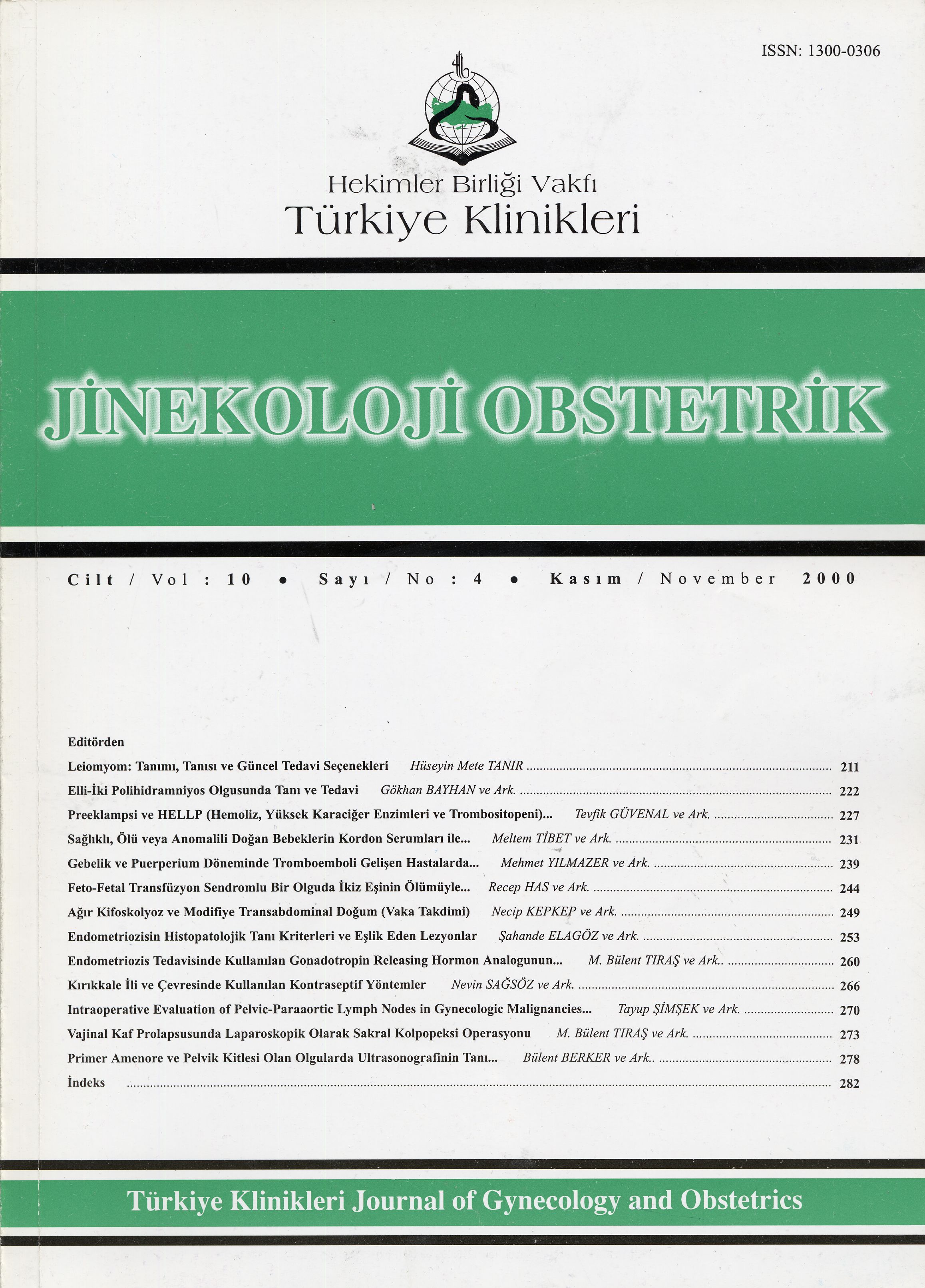Open Access
Peer Reviewed
ARTICLES
3195 Viewed1064 Downloaded
Prothrombin 2 21 G®A Mutation And Clinical Significance In Patients Diagnosed Thromboembolic Attack During Pregnancy And Puerperium
Gebelik ve Puerperium DönemindeTromboemboli Gelişen HastalardaProtrombin 2 21 G®A Mutasyonu ve Klinik Önemi
Turkiye Klinikleri J Gynecol Obst. 2000;10(4):239-43
Article Language: TR
Copyright Ⓒ 2025 by Türkiye Klinikleri. This is an open access article under the CC BY-NC-ND license (http://creativecommons.org/licenses/by-nc-nd/4.0/)
ÖZET
Amaç: Bu çalışmanın amacı gebelik ve puerperal dönemdeki tromboembolizm ile protrombin 20210 G®A mutasyonu arasındaki ilişkiyi araştırmaktır. Çalışma Planı: Biz gebelik ve puerperal dönemde venöz tromboz geçiren 35 kadın ve bir ya da iki normal gebelik geçiren 32 kadını inceledik. Sonuçlar: Protrombin genindeki G20210A mutasyonu tromboembolik komplikasyonu olan kadınların 2 (%5.7)sinde saptandı fakat tromboembolik komplikasyonu olmayan kadınların hiçbirinde bu mutasyon saptanmadı. Tartışma: Protrombin 20210 G®A mutasyonunun prevalansı tromboembolik komplikasyonu olan hastalarda daha yüksektir ancak iki grup arasında biz istatistiksel olarak anlamlı fark bulamadık. Bizim bulgularımızı destekleyecek ileri çalışmalar gereklidir.
Amaç: Bu çalışmanın amacı gebelik ve puerperal dönemdeki tromboembolizm ile protrombin 20210 G®A mutasyonu arasındaki ilişkiyi araştırmaktır. Çalışma Planı: Biz gebelik ve puerperal dönemde venöz tromboz geçiren 35 kadın ve bir ya da iki normal gebelik geçiren 32 kadını inceledik. Sonuçlar: Protrombin genindeki G20210A mutasyonu tromboembolik komplikasyonu olan kadınların 2 (%5.7)sinde saptandı fakat tromboembolik komplikasyonu olmayan kadınların hiçbirinde bu mutasyon saptanmadı. Tartışma: Protrombin 20210 G®A mutasyonunun prevalansı tromboembolik komplikasyonu olan hastalarda daha yüksektir ancak iki grup arasında biz istatistiksel olarak anlamlı fark bulamadık. Bizim bulgularımızı destekleyecek ileri çalışmalar gereklidir.
ANAHTAR KELİMELER: Tromboembolizm, Gebelik, Puerperium, Protrombin 2 21 G®A mutasyonu
ABSTRACT
Objective: The objective of this study is to evaluate the association between venous thromboembolism during pregnancy and puerperal period and prothrombin 20210 G®A mutation. Study Desing: We studied 35 women who had venous thrombosis during pregnancy and during puerperal period and 32 women who had one or more normal pregnancies. Results: The G20210A mutation on the prothrombin gene was found in 2 (5.7%) women with thromboembolic complication but this mutation was not found in any woman without thromboembolic complication. Conclusion: The prevelance of the prothrombin 20210 G®A mutation is high in patients with thromboembolic complication but we did not find statistical difference between two groups. Further studies are necessary to confirm and explain our findings.
Objective: The objective of this study is to evaluate the association between venous thromboembolism during pregnancy and puerperal period and prothrombin 20210 G®A mutation. Study Desing: We studied 35 women who had venous thrombosis during pregnancy and during puerperal period and 32 women who had one or more normal pregnancies. Results: The G20210A mutation on the prothrombin gene was found in 2 (5.7%) women with thromboembolic complication but this mutation was not found in any woman without thromboembolic complication. Conclusion: The prevelance of the prothrombin 20210 G®A mutation is high in patients with thromboembolic complication but we did not find statistical difference between two groups. Further studies are necessary to confirm and explain our findings.
MENU
POPULAR ARTICLES
MOST DOWNLOADED ARTICLES





This journal is licensed under a Creative Commons Attribution-NonCommercial-NoDerivatives 4.0 International License.










